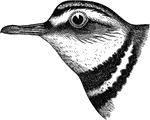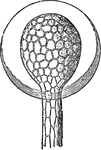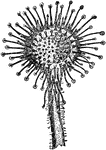Clipart tagged: ‘insectivorous’

Stone Chats
"Bill shorter than head, slender, straight, depressed at base, compressed at end, notched. Wings long,…

European Dipper
"Bill shorter that head, slender and compressed throughout, higher that broad at the nostrils, about…

Paradise Flycatcher
"Terpsiphone paradisi, Paradise Flycatchers, have fine crests, shorter in the female; while fleshy wattles,…

Ovenbird
"Golden-crowned Wagtail Warbler. Golden-crowned Accentor. Golden-crowned Thrush. Oven-bird. Seiurus…

Phalanger
"The Phalanger is a small woolly-coated marsupial, with opposable great toes, which are destitute of…

Kildeer Plover
"Aegialites vociferus. Kildeer Plover. Above, grayish-brown, with an olive shade, and in high plumage…

Sundew
"Leaf of Sundew, enlarged, with the tentacles on one side infected over a bit of meat placed on the…

Sundew
"Glands of Sundew magnified. External aspect with drop of secretion." — The Encyclopedia Britannica,…

Martin and Swallow
"Cotile riparia. Bank Swallow. lustreless mouse-brown; wings and tail fuscous. Below, white, with a…

Bank Swallow
"Cotile riparia. Bank Swallow. lustreless mouse-brown; wings and tail fuscous. Below, white, with a…

Cliff Swallow
"Cliff Swallow. Eaves Swallow. Crescent Swallow. Mud Swallow. back and top of head, with a spot on the…

Northern Black Cloud Swift
"Nephaecetes niger borealis. Northern Black Cloud Swift. Entire plumage sooty-black, with slight greenish…

European Greater Titmouse
"Head not crested. Wings and tail rounded, of approximately equal lengths, and about as long as the…

Venus Fly Trap
Venus Fly Trap is the common name of dionaea muscipula. The plant is insectivorous, meaning it eats…

